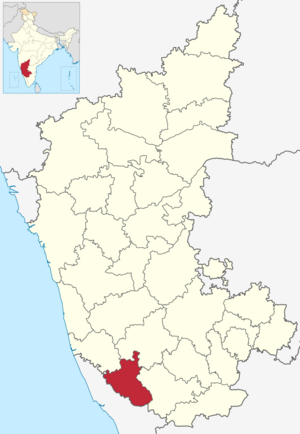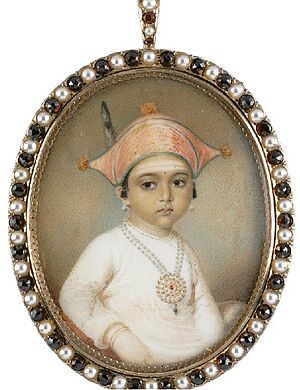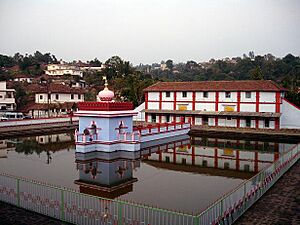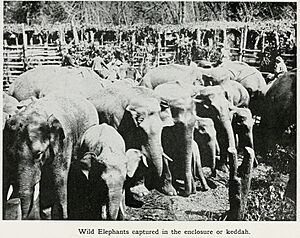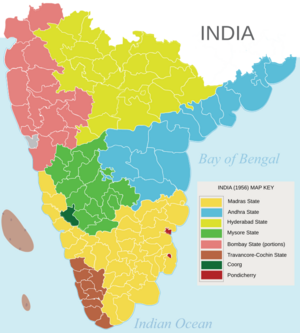History of Kodagu facts for kids
Kodagu is a beautiful district in Karnataka, India. It used to be a small kingdom called a "princely state." This article tells you about its interesting history.
Contents
Early History of Kodagu
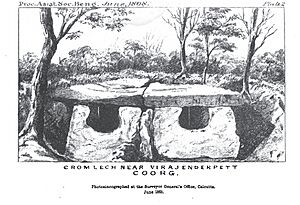
People first wrote about Kodagu a very long time ago, during the Sangam period (about 300 BCE to 300 CE). Back then, a kingdom called Ezhimala ruled two areas. One was a coastal area, and the other was a hilly region called Karkanadu. Karkanadu included parts of Kodagu.
Old writings in the Kannada language also talk about "Kudagu nad." This area included parts of Kodagu, Western Mysore, and Kerala. The name of the people who live there, the Kodavas, and the name of the region, Kodagu, are very similar.
The Haleri Dynasty
The Haleri dynasty was a family of rulers who came from another kingdom called Keladi. They became the kings of Kodagu. Kodagu was independent from the powerful Mysore kingdom at that time.
Early Haleri Rulers
A prince from the Keladi family took control of Kodagu. His family ruled Kodagu until 1834. In 1681, one of the kings, Muddu Raja, moved the capital city to Madikeri.
Challenges from Mysore
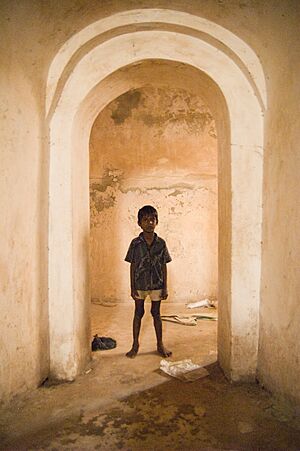
In the late 1760s, Hyder Ali, the ruler of Mysore, tried to invade Kodagu three times. But the Kodagu general, Kannanda Doddayya, defeated him.
In 1770, there was a disagreement about who should be king in Kodagu. Linga Raja asked Hyder Ali for help. Hyder Ali helped Linga Raja become king. In return, Linga Raja gave some land to Mysore and agreed to pay tribute.
When Linga Raja died in 1780, Hyder Ali took his young sons away. He put a governor in charge of Kodagu with Mysore soldiers. But in 1782, the Kodavas rebelled and drove out the Mysore troops.
Later, Hyder Ali's son, Tipu Sultan, tried to make peace with the Kodavas. But then he launched a surprise attack. Many Kodavas were killed, and over 40,000 ran into the forests to hide. A large number of Kodavas, including women and children, were captured. These prisoners were forced to change their beliefs and way of life. Young men were even forced to join Tipu's army.
Dodda Vira Raja's Escape
In 1788, Dodda Vira Rajendra (also called Vira Rajendra Wodeyar) escaped from being held captive. He was with his wife and brothers. He led a Kodava rebellion and joined forces with the British. Together, they drove Tipu Sultan's forces out of Kodagu.
Dodda Vira Raja built a new city called Virarajendrapet where he first met the British commander. Today, this city is usually called Virajpet.
Later Haleri Rulers
Dodda Vira Raja became very unwell towards the end of his rule. He died in 1809 without any sons. He left his favorite daughter, Devammji, to be the queen.
However, his brother, Linga Raja, took over the government in 1811. He died in 1820. His son, Chikka Veera Raja, became king at age twenty. He had many members of the royal family killed, including Devammaji.
In 1833, the British found out that Chikka Veera Raja was planning to betray them. After he refused to change his ways, the British sent an army into Kodagu in 1834. There was a short but fierce war. Many British soldiers were killed. Near Somwarpet, the Kodava warriors, led by Mathanda Appachu, fought very bravely. But the king had to surrender to the British. This war ended quickly.
British Rule in Kodagu
On April 11, 1834, the British removed the king from power. On May 7, Kodagu officially became part of the East India Company's land and was called Coorg.
In 1852, the former king, who was living in Vellore, got permission to visit England. He wanted his favorite daughter, Gauramma, to get a European education. On June 30, she was baptized, and Queen Victoria was one of her godmothers. Gauramma later married a British officer. She died in 1864. The king himself died in 1863.
Amara Sulya Freedom Movement
The Amara Sulya Freedom Movement started in 1837. This happened because the British separated Amara Sulya from Kodagu and made people pay a new tax in money. The British had also removed the king.
This movement wanted to bring back the old traditions instead of British rule. Leaders like Sri Kedambadi Ramè Gowda and Subedar Sri Guddemane Appaiah Gowda led this fight. After the rebellion, the British gave gifts to the Coorg chiefs who stayed loyal to them. They also gave a special Coorg Medal to those who supported them during the conflict.
Coorg (Kodagu) was the smallest province in India under British rule. It was managed by a commissioner. Later, freedom fighters from Kodagu also supported India's fight for independence. One famous person was Pandyanda Belliappa, known as Kodagu's Gandhi.
Kodagu in Independent India
After India became independent in 1947, Coorg became a province. In 1950, it became a state called Coorg State within the Republic of India. Elections for the Coorg Legislative Assembly were held in 1952.
In 1956, India's state borders were redrawn based on languages. Coorg then became a district of the state of Mysore. Mysore state later became the modern state of Karnataka. The district's official name went back to its original name, Kodagu.
Here are some of the chief commissioners who governed Coorg:
- 1947 – 1949 Dewan Bahadur Ketolira Chengappa
- 1949 – 1950 C.T. Mudaliar
- 1950 – 1956 Kanwar Daya Singh Bedi
The Chief Minister of Coorg from 1952 to 1956 was C.M. Poonacha.
Many people from Kodagu have joined the Indian army and played for the Indian hockey team. Famous people include Field Marshal K. M. Cariappa, General K.S. Thimayya, and hockey captain M P Ganesh. Rohan Bopanna, a well-known tennis player, is also from Kodagu.
See also
- Haleri Kingdom
- Kodagu
- Kodava


